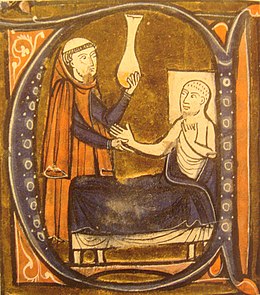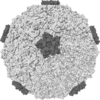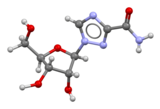The Viruses Portal
Welcome!

Viruses are small infectious agents that can replicate only inside the living cells of an organism. Viruses infect all forms of life, including animals, plants, fungi, bacteria and archaea. They are found in almost every ecosystem on Earth and are the most abundant type of biological entity, with millions of different types, although only about 6,000 viruses have been described in detail. Some viruses cause disease in humans, and others are responsible for economically important diseases of livestock and crops.
Virus particles (known as virions) consist of genetic material, which can be either DNA or RNA, wrapped in a protein coat called the capsid; some viruses also have an outer lipid envelope. The capsid can take simple helical or icosahedral forms, or more complex structures. The average virus is about 1/100 the size of the average bacterium, and most are too small to be seen directly with an optical microscope.
The origins of viruses are unclear: some may have evolved from plasmids, others from bacteria. Viruses are sometimes considered to be a life form, because they carry genetic material, reproduce and evolve through natural selection. However they lack key characteristics (such as cell structure) that are generally considered necessary to count as life. Because they possess some but not all such qualities, viruses have been described as "organisms at the edge of life".
Selected disease
Gastroenteritis is an inflammation of the gastrointestinal tract involving both the stomach and small intestine, which results in diarrhoea and vomiting, and sometimes abdominal pain. It is usually caused by a virus: most commonly rotavirus and norovirus, but also adenovirus and astrovirus. Other major infectious causes include Campylobacter, Escherichia coli, Vibrio cholerae and some other bacteria, as well as protozoa. Viruses, particularly rotavirus, cause about 70% of gastroenteritis episodes in children, while norovirus is the leading cause of gastroenteritis among adults in America, causing over 90% of outbreaks.
Transmission can be from consumption of improperly prepared foods or contaminated water, or by close contact with infectious individuals. Good sanitation practices and a convenient supply of uncontaminated water are important for reducing infection. Personal measures such as hand washing with soap can decrease incidence by as much as 30%. An estimated 2 billion cases of gastroenteritis occurred globally in 2015, mainly among children and people in developing countries, resulting in 1.3 million deaths. Gastroenteritis is usually an acute and self-limiting disease that does not require medication; the main treatment is rehydration using oral rehydration therapy. A rotavirus vaccine is available.
Selected image
Muhammad ibn Zakariya al-Razi was a Persian physician and chemist who, in the 9th century, was the first to document the distinction between the diseases of measles and smallpox.
Credit: Gerard of Cremona (c. 1250–60)
In the news
26 February: In the ongoing pandemic of severe acute respiratory syndrome coronavirus 2 (SARS-CoV-2), more than 110 million confirmed cases, including 2.5 million deaths, have been documented globally since the outbreak began in December 2019. WHO
18 February: Seven asymptomatic cases of avian influenza A subtype H5N8, the first documented H5N8 cases in humans, are reported in Astrakhan Oblast, Russia, after more than 100,0000 hens died on a poultry farm in December. WHO
14 February: Seven cases of Ebola virus disease are reported in Gouécké, south-east Guinea. WHO
7 February: A case of Ebola virus disease is detected in North Kivu Province of the Democratic Republic of the Congo. WHO
4 February: An outbreak of Rift Valley fever is ongoing in Kenya, with 32 human cases, including 11 deaths, since the outbreak started in November. WHO
21 November: The US Food and Drug Administration (FDA) gives emergency-use authorisation to casirivimab/imdevimab, a combination monoclonal antibody (mAb) therapy for non-hospitalised people twelve years and over with mild-to-moderate COVID-19, after granting emergency-use authorisation to the single mAb bamlanivimab earlier in the month. FDA 1, 2
18 November: The outbreak of Ebola virus disease in Équateur Province, Democratic Republic of the Congo, which started in June, has been declared over; a total of 130 cases were recorded, with 55 deaths. UN
Selected article
Interferons are a group of signalling proteins released by host cells in response to viruses and other pathogens. They belong to a large class of proteins known as cytokines: molecules used for communication between cells to trigger the protective defences of the immune system that help to eradicate pathogens. More than twenty distinct interferon genes and proteins have been identified in animals, including humans.
When a cell is infected by a virus, several virus products, including glycoproteins and viral RNA, stimulate the cell to produce and release interferons. This causes nearby cells to heighten their defences against viral infection, and so interferes with viral replication. Some viruses, including Japanese encephalitis virus, dengue type 2 virus, human cytomegalovirus and Kaposi's sarcoma-associated herpesvirus, have evolved ways to resist interferon's antiviral activity. Interferons also have various other functions in regulating the immune system. Interferons and other cytokines are responsible for some symptoms of infection, such as fever, muscle pain and "flu-like symptoms".
Selected outbreak
In the severe acute respiratory syndrome (SARS) outbreak, the first cases of the newly emerged SARS coronavirus were reported in November 2002 from the Chinese Guangdong province. The virus soon spread across Asia, with China, Hong Kong, Taiwan and Singapore being the worst affected countries; a secondary outbreak occurred in Canada. The rapid initial spread of the outbreak has been in part attributed to China's slow response to the early cases. Over 8,000 people were infected, with a case fatality rate of 11%. Those over 65 years had a much higher mortality rate, greater than 55%. The outbreak was contained by July 2003, and no cases have been reported since 2004.
At the time of the outbreak, the immediate source of SARS coronavirus was thought to have been the masked palm civet (Paguma larvata; pictured), which was sold as food in Guangdong markets. The virus was also found in raccoon dogs, ferret badgers and domestic cats. More recent research has suggested that the natural reservoir could be horseshoe bats.
Selected quotation
| “ | An inefficient virus kills its host. A clever virus stays with it. | ” |
Recommended articles
Viruses & Subviral agents: bat virome • elephant endotheliotropic herpesvirus • HIV • introduction to viruses![]() • Playa de Oro virus • poliovirus • prion • rotavirus
• Playa de Oro virus • poliovirus • prion • rotavirus![]() • virus
• virus![]()
Diseases: colony collapse disorder • common cold • croup • dengue fever![]() • gastroenteritis • Guillain–Barré syndrome • hepatitis B • hepatitis C • hepatitis E • herpes simplex • HIV/AIDS • influenza
• gastroenteritis • Guillain–Barré syndrome • hepatitis B • hepatitis C • hepatitis E • herpes simplex • HIV/AIDS • influenza![]() • meningitis
• meningitis![]() • myxomatosis • polio
• myxomatosis • polio![]() • pneumonia • shingles • smallpox
• pneumonia • shingles • smallpox
Epidemiology & Interventions: 2007 Bernard Matthews H5N1 outbreak • Coalition for Epidemic Preparedness Innovations • Disease X • 2009 flu pandemic • HIV/AIDS in Malawi • polio vaccine • Spanish flu • West African Ebola virus epidemic
Virus–Host interactions: antibody • host • immune system![]() • parasitism • RNA interference
• parasitism • RNA interference![]()
Methodology: metagenomics
Social & Media: And the Band Played On • Contagion • "Flu Season" • Frank's Cock![]() • Race Against Time: Searching for Hope in AIDS-Ravaged Africa
• Race Against Time: Searching for Hope in AIDS-Ravaged Africa![]() • social history of viruses
• social history of viruses![]() • "Steve Burdick" • "The Time Is Now" • "What Lies Below"
• "Steve Burdick" • "The Time Is Now" • "What Lies Below"
People: Brownie Mary • Macfarlane Burnet![]() • Bobbi Campbell • Aniru Conteh • people with hepatitis C
• Bobbi Campbell • Aniru Conteh • people with hepatitis C![]() • HIV-positive people
• HIV-positive people![]() • Bette Korber • Henrietta Lacks • Linda Laubenstein • Barbara McClintock
• Bette Korber • Henrietta Lacks • Linda Laubenstein • Barbara McClintock![]() • poliomyelitis survivors
• poliomyelitis survivors![]() • Joseph Sonnabend • Eli Todd • Ryan White
• Joseph Sonnabend • Eli Todd • Ryan White![]()
Selected virus
Henipaviruses are a genus of RNA viruses in the Paramyxoviridae family. The variably shaped, 40–600 nm diameter, enveloped capsid contains a single-stranded, negative-sense RNA genome of 18.2 kb, with six genes. The cellular receptor is in the ephrin family. The natural hosts are predominantly bats, mainly the Pteropus genus of megabats (flying foxes) and some microbats. Bats infected with Hendra virus develop viraemia and shed virus in urine, faeces and saliva for around a week, but show no signs of disease. Henipaviruses can also infect humans and livestock, causing severe disease with high mortality, making the group a zoonootic disease. Transmission to humans sometimes occurs via an intermediate domestic animal host.
The first henipavirus, Hendra virus, was discovered in 1994 as the cause of an outbreak in horses in Brisbane, Australia. Nipah virus was identified a few years later in Malaysia as the cause of an outbreak in pigs. Three further species have since been recognised: Cedar and Kumasi viruses in bats, and Mòjiāng virus in rodents. Their emergence as human pathogens has been linked to increased contact between bats and humans. Human disease has been confined to Australia and Asia, but members of the genus have also been found in African bats. A veterinary vaccine against Hendra virus is available but no human vaccine has been licensed.
Did you know?
- ...that the groundnut rosette virus, which causes serious damage to peanut crops in Africa (plant pictured), is spread by the groundnut aphid?
- ...that Oguntola Sapara infiltrated and exposed a secret society in Nigeria that was deliberately spreading smallpox?
- ...that with the 2008 bird flu outbreak in West Bengal, 16,000 birds were destroyed in Itahar, but health workers retreated from villages that refused to kill their birds?
- ...that Preparing for Emergencies was a British Home Office programme to increase public safety after several major disasters, including the Madrid bombings, SARS outbreak and UK foot and mouth crisis?
- ...that Sounds of HIV sets the genome of the HIV/AIDS virus to music?
Selected biography
Thomas Flewett (29 June 1922 – 12 December 2006) was a British–Irish virologist and an authority on electron microscopy of viruses, best known for his role in the discovery of rotaviruses. After Ruth Bishop and others discovered viruses associated with diarrhoea, Flewett showed that they could be visualised by electron microscopy directly in faeces. He dubbed them "rotaviruses" for their wheel-shaped appearance. His group described the different rotavirus serotypes, and did extensive research on the rotavirus varieties infecting many animals.
Flewett established one of the first English virus laboratories in Birmingham in 1956. In addition to his rotavirus work, he discovered the cause of hand, foot and mouth disease, identified two new species of adenovirus, and co-discovered human torovirus and picobirnaviruses. His other research included influenza, coxsackie A, coxsackie B and hepatitis B viruses.
In this month
1 September 1910: Peyton Rous shows that a sarcoma of chickens, subsequently associated with Rous sarcoma virus, is transmissible
3 September 1917: Discovery of bacteriophage of Shigella by Félix d'Herelle
8 September 1976: Death of Mabalo Lokela, the first known case of Ebola virus
8 September 2015: Discovery of giant virus Mollivirus sibericum in Siberian permafrost
11 September 1978: Janet Parker was the last person to die of smallpox
12 September 1957: Interferon discovered by Alick Isaacs and Jean Lindenmann
12 September 1985: Structure of human rhinovirus 14 (pictured) solved by Michael Rossmann and colleagues, the first atomic-level structure of an animal virus
17 September 1999: Jesse Gelsinger died in a clinical trial of gene therapy using an adenovirus vector, the first known death due to gene therapy
20 September 2015: Wild poliovirus type 2 declared eradicated
26 September 1997: Combivir (zidovudine/lamivudine) approved; first combination antiretroviral
27 September 1985: Structure of poliovirus solved by Jim Hogle and colleagues
28 September 2007: First World Rabies Day is held
Selected intervention
Ribavirin is a nucleoside analogue that mimics the nucleoside guanosine. It shows some activity against a broad range of DNA and RNA viruses, but is less effective against dengue fever, yellow fever and other flaviviruses. The drug was first synthesised in the early 1970s by Joseph T. Witkowski and Roland K. Robins. Ribavirin's main current use is against hepatitis C, in combination with pegylated interferon, nucleotide analogues and protease inhibitors. It has been used in the past in an aerosol formulation against respiratory syncytial virus-related diseases in children. Ribavirin has been used in combination as part of an experimental treatment for rabies. It is also the only available treatment for the viruses causing some viral haemorrhagic fevers, including Lassa fever, Crimean–Congo haemorrhagic fever and hantavirus disease, but is ineffective against the filovirus diseases, Ebola and Marburg. Clinical use is limited by the drug building up in red blood cells to cause haemolytic anaemia.
Subcategories
Subcategories of virology:
Topics
Things to do
- Comment on what you like and dislike about this portal
- Join the Viruses WikiProject
- Tag articles on viruses and virology with the project banner by adding {{WikiProject Viruses}} to the talk page
- Assess unassessed articles against the project standards
- Create requested pages: red-linked viruses | red-linked virus genera
- Expand a virus stub into a full article, adding images, citations, references and taxoboxes, following the project guidelines
- Create a new article (or expand an old one 5-fold) and nominate it for the main page Did You Know? section
- Improve a B-class article and nominate it for Good Article
 or Featured Article
or Featured Article status
status - Suggest articles, pictures, interesting facts, events and news to be featured here on the portal
WikiProjects & Portals
 WikiProject Viruses
Related WikiProjects
WikiProject Viruses
Related WikiProjects
Medicine • Microbiology • Molecular & Cellular Biology • Veterinary Medicine
Related PortalsAssociated Wikimedia
The following Wikimedia Foundation sister projects provide more on this subject:
-
Commons
Free media repository -
Wikibooks
Free textbooks and manuals -
Wikidata
Free knowledge base -
Wikinews
Free-content news -
Wikiquote
Collection of quotations -
Wikisource
Free-content library -
Wikispecies
Directory of species -
Wikiversity
Free learning tools -
Wiktionary
Dictionary and thesaurus


















